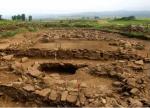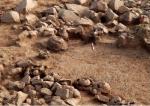Summary (English)
ARCHAEOLOGICAL EXPLORATIONS NEAR THE VILLAGE OF DELYAN (Philip Mihailov – philip.mihaylov@gmail.com) Three parallel rows of graves situated under stone piles were documented, oriented northeast – southwest. The deceased were cremated outside the stone funerary constructions. In part of the burials the ashes and the grave goods were placed in funerary urns, while in the other burials the ashes and the grave goods were spread over the stones or between them. The earliest burials dated to the 11th – 9th centuries BC and were ceramic urns, containing ashes, covered with dishes or bowls and placed inside pits dug out into the ancient terrain. Structures Nos. 5 and 6 were low tumuli, c. 13 m in diameter, which were constructed and used for a long period: from the Early through the Late Iron Ages. Most of the stone funerary constructions (Structures Nos. 1 – 3, 9, 10, 11, 15 and 21) were built during the beginning of the Late Iron Age. Side funerary stone structures adjoined all central stone structures and contained graves and fragmentary Thracian pottery, jewelry (fibulae, glass and amber beads), spearheads and elements of horse trappings. Over 55 graves of the 11th – 9th centuries BC and approximately the same number of the 6th – 4th centuries BC were explored. The most impressive grave goods of the 6th – 4th centuries BC included gold pectorals, a gold appliqué, a silver ring, earrings, silver lunulae, a silver jewel, elements from a horse bit and horse trappings, gilded bronze tweezers, silver, bronze and glass beads, a bronze spiral bracelet, iron knives and spearheads.
- Philip Mihailov - Museum of History – Pernik
Director
- Philip Mihailov - Museum of History – Pernik
Team
Research Body
- Museum of History – Pernik






![Download [PDF]](/excavation/skins/fasti/images/results/download_sml.png)
